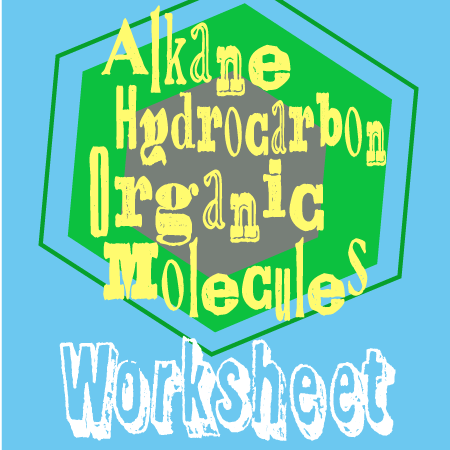
Alkanes are hydrocarbons. This means molecules that only contain the elements C for carbon and H for hydrogen. No other elements.
Alkanes are the simplest organic molecules. Alkanes are often petrochemicals, derived from crude petroleum oil. Organic molecules are those based on carbon, and crude oil contains lots of carbon because it was a living plant or algae some millions of years ago. The carbon bonds have lots of energy, and alkanes are typical fuel molecules. For example, methane is commonly called natural gas, the gas that may heat your kitchen stove if it has a flame.
Alkanes normally have a carbon chain with only single bonds (not double or triple) between the carbon atoms. The general formula for alkanes is CxHx+2, where x is the number of carbon atoms in the carbon chain.
Download and print the black and white pdf. It’s 1 printer-friendly page.
Naming alkanes is like counting to ten in chemistry.
Methane, ethane, propane, butane is like saying 1, 2, 3, 4 in alkane chemistry. Specifically, the prefixes meth-, eth-, prop-, and but- refer to molecules with 1 carbon atom, 2 carbons, 3 carbons, and 4 carbons respectively. You just have to memorize these first four prefixes.
Then is gets easy. Pent- means 5. Hex- means 6. Hept- means 7. Oct- means 8. Non- means 9 (non- not nin-). Finally, dec- means 10 as in the word “decade.”
methane CH4
ethane C2H6
propane C3H8
butane C4H10
pentane C5H12
hexane C6H14
heptane C7H16
octane C8H18
nonane C9H20
decane C10H22
methane CH4
ethane CH3CH3
propane CH3CH2CH3
butane CH3CH2CH2CH3
pentane CH3CH2CH2CH2CH3
hexane CH3CH2CH2CH2CH2CH3
heptane CH3CH2CH2CH2CH2CH2CH3
octane CH3CH2CH2CH2CH2CH2CH2CH3
nonane CH3CH2CH2CH2CH2CH2CH2CH2CH3
decane CH3CH2CH2CH2CH2CH2CH2CH2CH2CH3
The prefix prop- means a 3 carbon chain. To get the number of hydrogen atoms in the propane molecule, apply the general formula for alkanes CxHx+2, where x is 3. Double 3 and add 2 more, for 6 + 2 = 8. So there are 8 hydrogen atoms. The propane formula is C3H8.
The condensed formula might be written as CH3CH2CH3 to better show the propane structure. The carbon atoms on the end of the carbon chain will always have 3 hydrogens attached, while those in the middle always have 2 hydrogens attached.
Propane is often used as the gas in a barbeque or outdoor grill, assuming it doesn’t use charcoal.
The prefix but- means a 4 carbon chain. To get the number of hydrogen atoms in the butane molecule, apply the alkane formula CxHx+2, where x is 4. Double 4 and add 2 more, for 8 + 2 = 10. The butane formula is C4H10.
The condensed formula might be written as CH3CH2CH2CH3 to better show the butane structure.
Butane is often used as lighter fuel or charcoal lighter fluid.
The alkane hexane has 6 carbons, just like a hexagon has 6 sides. Double 6 and add 2 to make 14 H atoms. The hexane formula is C6H14.
The hydrocarbon chain could also be written like CH3CH2CH2CH2CH2CH3.
Hexane, unlike the other alkanes, is rarely used as a fuel. It is an important solvent used in chemistry laboratories. It often dissolves chemicals that won’t dissolve in water.
The alkane octane has 8 carbons, just like an octagon has 8 sides.
The octane structure can be written as CH3CH2CH2CH2CH2CH2CH2CH3 to better illustrate the carbon chain. It adds up to C8H18.
You may see the word octane on gasoline pumps. Gasoline contains many chemicals, including octane and similar molecules.